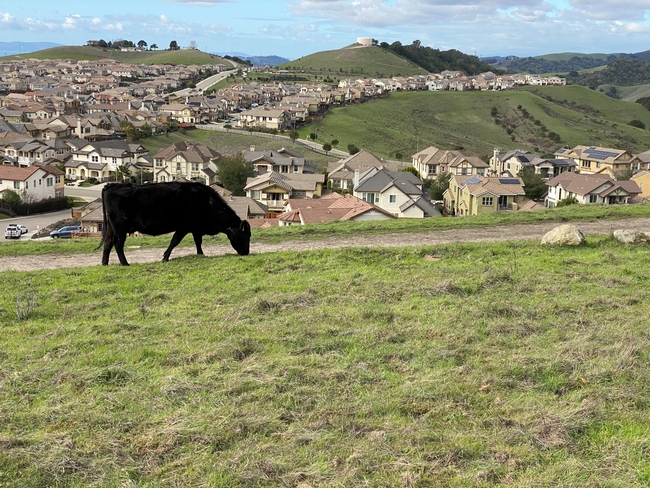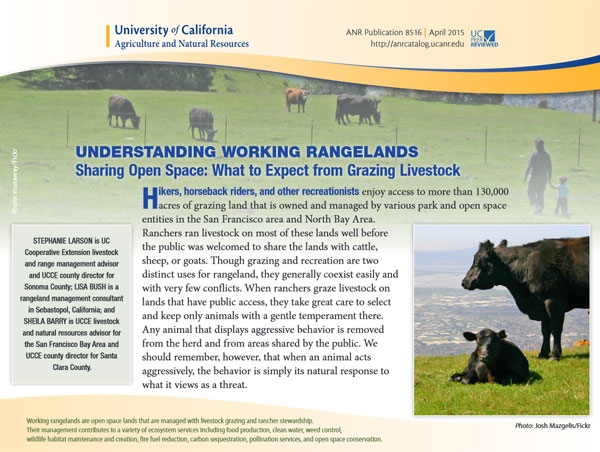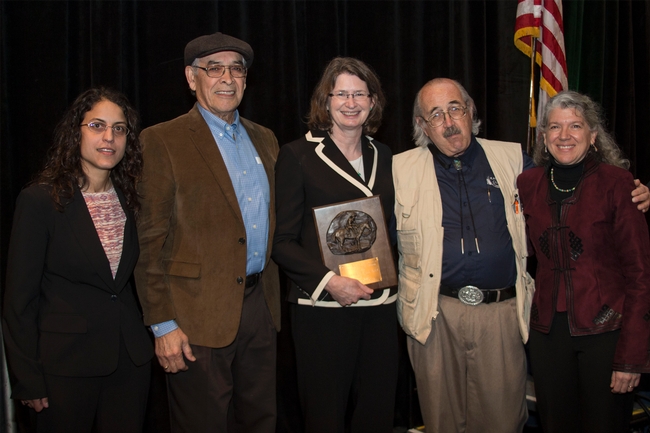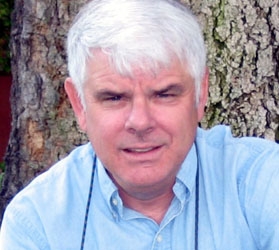Posts Tagged: rangelands
New UC ANR publication educates public on cycles of cattle production, grazing and economics
The pandemic has brought more people into nearby parks and public lands for hiking, biking and other recreational activities. In areas like the East Bay Regional Parks – a San Francisco Bay Area park system totaling more than 120,000 acres where about 65% of the land is grazed by livestock – visitors might see goats, sheep and, most likely, cattle.
Those encounters with animals (or their manure) represent a prime opportunity for members of the public to learn about agriculture and the ecological benefits of rangelands, according to Larry Forero, a UC Cooperative Extension livestock and natural resources advisor.
As livestock grazing (mostly by beef cattle) constitutes a significant portion of land use across the state, Forero – along with fellow UCCE advisors Sheila Barry and Stephanie Larson – recently authored a UC Agriculture and Natural Resources publication summarizing the mechanics of cattle production.
“Beef Cattle on California Annual Grasslands: Production Cycle and Economics,” published in October and available as a free download on the UC ANR Catalog, describes the seasonal phases of cattle production and the factors that impact ranchers' financial calculations and management decisions.
“This concise publication walks through annual stock flows and calendar of operations and gives tables for estimating costs, return over cash, and gross income under various scenarios,” said Forero.
“Even if only a relatively small percentage of park goers are interested, you still touch a lot of people with a document like this,” Forero explained.
He said he hopes park signage and QR codes will direct visitors to the publication for more information about the cattle and their seasonal movements.
“People often wonder where the cattle go when they leave the park and when they will return,” co-author Sheila Barry said. “The cattle may go to grass or feed yards in other places in California or even out of state.”
But, as this new UC ANR publication explains, the cattle production cycle turns over anew.
“There will be more cattle next fall, I promise,” Barry said.
UC ANR publication helps hikers co-exist with cows
Hikers, cyclists and runners can learn to enjoy nature alongside grazing cattle with information from a new UC Agriculture and Natural Resources publication, reported Andrew McGall in the Contra Costa Times.
Sharing Open Space: What to Expect from Grazing Livestock, written by Stephanie Larson, UC ANR Cooperative Extension livestock advisor, is available free in ANR Catalog.
The publication explains how to read the behavior patterns of cows with calves, heifers, steers and bulls. For example, when approaching a cow on the trail, it's best to stay in it's "flight zone" to encourage it to move out of the way.
The guideline says dogs accompanying hikers must be kept under control.
"Cattle see dogs as predators," the brochure warns. "This is especially true for mother cows, who naturally become aggressive when trying to protect their young."
The story was also covered by the Sacramento Bee on May 27:
Moooving along: How to handle a cow on the trail
Sam McManis, Sacramento Bee, May 27, 2015
Waving one's arms, clapping and yelling? Not recommended, according to a new downloadable brochure, “Sharing Open Space: What to Expect From Grazing Livestock,” published by University of California Division of Agriculture and Natural Resources. “(Cattle) don't necessarily react how you expect them to, because of that issue with the flight zone,” said Sheila Barry, UC ANR Cooperative Extension advisor. “So, you think, ‘Hey, I'm getting really close, why aren't you moving, cow?' Most will move off, eventually. But there's part of it that's just not predictable.”
Allen-Diaz honored by range management professionals
The premier award is given annually to SRM members who have sustained accomplishments or contributions to rangeland management during the last ten years.
“Barbara has a record of outstanding research productivity that has affected the understanding and management of California rangelands and has had global impacts,” said Amy Ganguli, assistant professor of range science at New Mexico State University.
“Barbara is also a well-regarded educator who has mentored several graduate students and young professionals who are making significant contributions to rangeland and natural resource management,” said Ganguli, who, along with Fee Busby, Utah State University wildland resources professor, nominated her for the award.
This is not the first time Allen-Diaz has been recognized by her peers for her research on the effects of livestock grazing on natural resources, oak woodlands and ecosystems of the Sierra Nevada. The national society honored her with its Outstanding Achievement Award in 2001, and the following year the California chapter named her Range Manager of the Year.
In 2007, Allen-Diaz was among 2,000 scientists recognized for their work on the Intergovernmental Panel on Climate Change when the Nobel Peace Prize was awarded jointly to the IPCC and Vice President Al Gore. Allen-Diaz's contributions focused on the effects of climate change on rangeland species and landscapes. She has authored more than 170 research articles and presentations. She has been an active member of the Society for Range Management, serving on its board of directors and on various government panels.
Allen-Diaz, who has served as UC ANR's vice president since 2011, is also a tenured UC Berkeley faculty member in the College of Natural Resources and currently holds the prestigious Russell Rustici Chair in Rangeland Management. She has been with the University of California since 1986. She earned her bachelor's, master's and doctoral degrees at UC Berkeley.
UCCE specialist George retires after 34 years of improving rangelands
“Mel has been a mentor and leader within the range science community his entire career,” said Ken Tate, UC Cooperative Extension specialist, who holds the Russell L. Rustici Endowed Chair in Rangeland Watershed Sciences. “Mel’s ability to see emerging issues on rangelands, and to position UC ahead of these issues, has allowed us to keep our research and extension at the forefront of rangeland management.”
When George arrived at UC Davis in 1978, he was responsible mainly for forage trials, helping ranchers keep their land productive. But George could see issues with grazing and water quality on the horizon and worked to head them off at the pass.
In the early 1990s, he spearheaded the UC Cooperative Extension Rangeland Watershed Program, which uses education and applied research to help ranchers and regulators mitigate the risk of pathogens in water runoff from rangeland. Some 80 percent of California’s water passes through or is stored on rangeland and the UC Cooperative Extension Rangeland Watershed Program has helped develop management practices that keep that water clean.
“The Rangeland Management Program has been a tremendous help in protecting open space, habitat for plants and wildlife and healthy watersheds that California rangelands provide,” says Tracy Schohr, director of the California Rangeland Conservation Coalition, a band of 100 diverse environmental, ranching and policymaking groups committed to protecting the state’s diminishing rangeland. “They educate land managers and provide the objective, accurate information we need.”
George’s research and extension has improved millions of acres of rangeland in the United States, Africa, Europe, China and beyond. In 1991, for example, George worked with Chinese researchers to develop a research site in the Tibetan Plateau of Szechwan Province, helping develop a winter feeding program for their yak herds that doubled the survival of yak calves. In 1994, George helped Albania develop grazing practices to protect new forest plantations to replace those destroyed during the transition from Communist to democratic rule.
The list goes on and on.
“Mel has a knack for taking a complicated process and making it navigable for ranchers and other land managers,” says Tate who, like George, has been based in the UC Davis Department of Plant Sciences. “He has greatly advanced both the art and science of rangeland management.”
George got into range management in a round-about way, a journey that passed through farming and animal science and was nearly cut short by a plane crash.
Farming is in George’s blood going back 15 generations, a fact he learned not too long ago when he became a genealogy buff. He was raised in the Butte County town of Gridley and was the first in his family to attend college, receiving his bachelor’s degree in animal science from California State University, Chico. During his senior year at Chico, a professor interested him in range management, which led him to Texas Tech where he received his master’s in range management in August 1969.
The Vietnam War was in progress and in October 1969, George was drafted into the U.S. Army. In November 1970, he boarded a plane bound for active duty that crashed during takeoff, killing 40 people aboard. George was severely burned.
“But I lived, and was released with a medical profile that prevented me from going to a war zone,” George says.
He was stationed at Fort Ord until the summer of 1971 when he and his wife, Gail, moved to Logan, Utah, where George earned his Ph.D. in range ecology at Utah State University. He worked nearly three years on the faculty at California Polytechnic State University, San Luis Obispo, before coming to UC Davis in 1978.
George has earned countless awards over the years, including the Outstanding Alumnus at Utah State University in 2000, the prestigious James H. Meyer Distinguished Achievement Award at UC Davis in 2007 and the College of Agriculture Distinguished Alumnus Award from Chico State University in 2008.
George will stay busy in retirement, still working on a slew of rangeland research projects under way in the UC Davis Department of Plant Sciences.
“It’s such a fascinating field because rangeland is the most complex agricultural system there is,” George says. “You have to be willing to think outside the box to manage so many moving parts, and I like that. There are so many issues on the horizon like carbon storage and protecting biodiversity.”
And even in retirement, George will do all he can to keep our rangelands healthy and sustainable for generations to come.
Landowners share views on forest and range resources
October 10, 2011
Private owners of California’s forests and rangelands value their land mostly for its natural amenities and as a financial investment, according to a new study published in the October–December 2011 issue of the University of California’s California Agriculture journal. About 42 percent of forest and rangeland is in private ownership.
“A variety of reasons were reported for owning land,” reports lead author Shasta Ferranto, Ph.D. candidate in UC Berkeley Department of Environmental Science, Policy and Management.
“To ‘live near natural beauty’ was the objective ranked by most landowners as important. Other popular reasons included ‘appreciation in land value,’ ‘escape from city crime and pollution,’ ‘financial investment’ and ‘live in a small community.’” The research article, and the entire October–December 2011 issue, can be viewed and downloaded at http://californiaagriculture.ucanr.org.
Thirty-four million acres of California’s forests and rangelands are privately owned. These lands represent 34 percent of the total land in the state and provide important ecosystem services such as pollination, wildlife habitat and carbon sequestration (removal of carbon from the atmosphere and storage in carbon sinks such as forests). However, little was known about the people who own and manage the land until this recent survey by UC Cooperative Extension and UC Berkeley scientists.
Many of the more than 600 forest and rangeland owners in 10 counties who completed the 17-page survey reported they had been approached to sell their land for development. Other findings include
- Owners of large properties (500 or more acres) were more likely to carry out or be interested in environmental improvements than owners of small properties.
- Only about one-third of landowners had participated in conservation programs; few had conservation easements.
- The majority of the landowners were primary residents.
- Only one-third reported earning income from their land.
- Asked about what reasons would influence a hypothetical future decision to sell their land, almost 20 percent reported they would never sell their land. Of the remaining 80 percent, just over half chose “it is too much work to maintain,” followed by “can’t afford to keep it” and other financial concerns.
“What will happen when privately owned forests and rangelands change ownership — either through generational transfer of land or sale — is unknown,” say the researchers. “California forest and rangeland owners are 62 years old on average, with a high proportion retired, and many more nearing retirement.” The survey results establish a baseline for understanding how the owners of a significant part of the state’s ecosystem services “might change over time, or with interventions of information, policy or financial resources.”
Also reported in the October-December 2011 issue of California Agriculture:
- A wireless communications system and wetting-front advance model have eliminated tail water drainage in alfalfa irrigation.
- Tree shelters and weed control have increased the growth and survival of natural blue oak seedlings and are more cost-effective than a previous approach to regenerate blue oaks stands by planting nursery-grown saplings.
- Hedgerows of native California shrubs and perennial grasses are enhancing beneficial insects on farms in California’s Central Valley.
California Agriculture is the University of California’s peer-reviewed journal of research in agricultural, human and natural resources. For a free subscription, sign up at http://californiaagriculture.ucanr.org, or write to calag@ucdavis.edu.
WRITERS/EDITORS: To request a hard copy of the journal, email crllopez@ucdavis.edu.

191-1437






